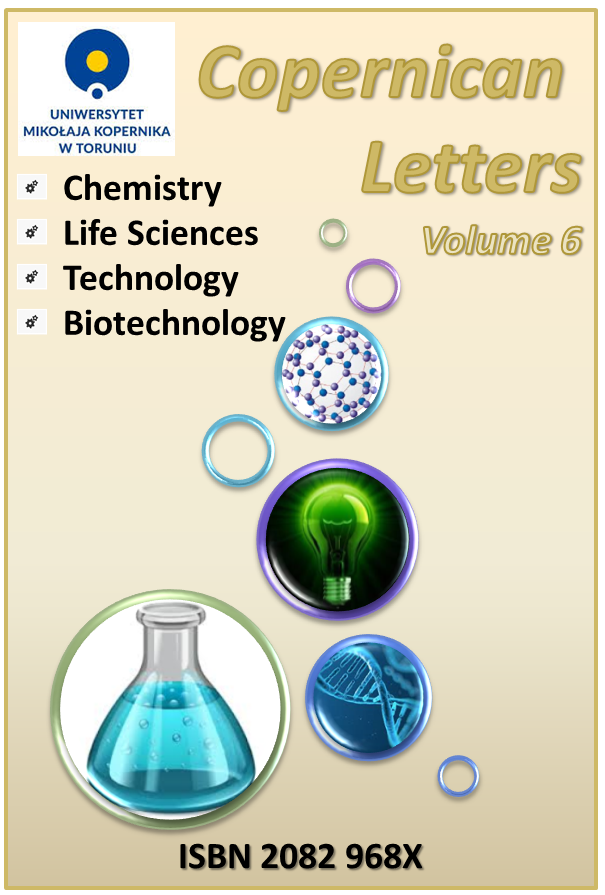Innovations in electromembrane processes
DOI:
https://doi.org/10.12775/CL.2015.005Keywords
electrodialysis, electrodialysis reversal, reverse electrodialysis, electrodeionization, membrane capacitive deionizationAbstract
Electromembrane processes are increasingly important group of separation methods, widely used for removal of charged components from solutions. It is a growing field of research with a plethora of both existing and still developed applications. The separation is based on ion migration across the charged membranes (a polymeric matrix with fixed charged groups, counterbalanced with mobile counter-ions), placed in the electric field. This paper presents the main electromembrane processes: electrodialysis (ED), electrodialysis reversal (EDR), electrodialysis with bipolar membrane (EDBM), electrodeionization (EDI), membrane capacitive deionization (MCDI), reverse electrodialysis (RED). We present the common applications of electromembrane processes and discuss the physical basis of the electromembrane processes. The most important parameters of the ion-exchange membranes are discussed, as well as the novel approaches towards mitigation of scaling, enhancement of mass transfer, decreasing the concentration polarization, and new hybrid electromembrane processes. Critical analysis of the possibility of energy production by reverse electrodialysis is presented.
References
. Valero F., Arbós R., Desalination of brackish river water using electrodialysis reversal (EDR): control of the THMs formation in the barcelona (NE spain) area, Desalination 253 (2010) 170–174.
. Goodman N. B., Taylor R. J., Xie Z., Gozukara Y., Clements A., A feasibility study of municipal wastewater desalination using electrodialysis reversal to provide recycled water for horticultural irrigation, Desalination 317 (2013) 77–83.
. Turek M., Dydo P., Klimek R., Salt production from coal-mine brine in ED–evaporation–crystallization system, Desalination 184 (2005) 439–446.
. Reig M., Casas S., Aladjem C., Valderrama C., Gilbert O., Valero F., Centeno C. M., Larrotcha E., Cortina J. L., Concentration of NaCl from seawater reverse osmosis brines for the chlor-alkali industry by electrodialysis, Desalination 342 (2014) 107–117.
. Turek M., Mitko K., Chorążewska M., Dydo P., Use of the desalination brines in the saturation of membrane electrolysis feed, Desalin. Water Treat. 51 (2013) 2749–2754.
. Casas S., Bonet N., Aladjem C., Cortina J. L., Larrotcha E., Cremades L., Modelling sodium chloride concentration from seawater reverse osmosis brine by electrodialysis: Preliminary results, Solvent Extr. Ion Exch. 29 (2011) 488–508.
. Turek M., Mitko K., Bandura-Zalska B., Ciecierska K., Dydo P., Ultra-pure water production by integrated electrodialysis-ion exchange/electrodeionization, Membr. Water Treat. 4 (2013) 237–249.
. Nagarale R., Gohil G., Shahi V. K., Recent developments on ion-exchange membranes and electro-membrane processes, Adv. Colloid Interface Sci. 119 (2006) 97–130.
. Tanaka Y., Ion Exchange Membranes: Fundamentals and Applications, Elsevier, 2015.
. Park J.-S., Song J.-H., Yeon K.-H., Moon S.-H., Removal of hardness ions from tap water using electromembrane processes, Desalination 202 (2007) 1–8.
. Gurreri L., Tamburini A., Cipollina A., Micale G., Ciofalo M., CFD simulation of mass transfer phenomena in spacer filled channels for reverse electrodialysis applications, Chem. Eng. Trans. 32 (2013) 1879–1884.
. Balster J., Pünt I., Stamatialis D. F., Wessling M., Multi-layer spacer geometries with improved mass transport, J. Membr. Sci. 282 (2006) 351–361.
. Turek M., Dydo P., Electrodialysis reversal of calcium sulphate and calcium carbonate supersaturated solution, Desalination 158 (2003) 91–94.
. Gurreri L., Tamburini A., Cipollina A., Micale G., Ciofalo M., CFD prediction of concentration polarization phenomena in spacer-filled channels for reverse electrodialysis, J. Membr. Sci. 468 (2014) 133–148.
. Stroock A. D., Chaotic mixer for microchannels, Science 295 (2002) 647–651.
. Shaposhnik V. A. , Grigorchuk O. V., Korzhov E. N., Vasil’eva V. I., Klimov V. Y., The effect of ion-conducting spacers on mass transfer – numerical analysis and concentration field visualization by means of laser interferometry, J. Membr. Sci. 139 (1998) 85–96.
. Wibisono Y., Cornelissen E., Kemperman A., van der Meer W., Nijmeijer K., Two-phase flow in membrane processes: A technology with a future, J. Membr. Sci. 453 (2014) 566–602.
. Mikhaylin S., Nikonenko V., Pourcelly G., Bazinet L., Intensification of demineralization process and decrease in scaling by application of pulsed electric field with short pulse/pause conditions, J. Membr. Sci. 468 (2014) 389–399.
. Turek M., Waś J., Mitko K., Scaling prediction in electrodialytic desalination, Desalin. Water Treat. 44 (2012) 255–260.
. Cifuentes-Araya N., Pourcelly G., Bazinet G., How pulse modes affect proton-barriers and anion-exchange membrane mineral fouling during consecutive electrodialysis treatments, J. Colloid Interface Sci. 392 (2013) 396–406.
. Ben Salah Sayadi I., Sistat P., Tlili M. M., Assess of physical antiscale-treatments on conventional electrodialysis pilot unit during brackish water desalination, Chemical Engineering and Processing: Process Intensification 88 (2015) 47–57.
. Wen R., Deng S., Zhang Y., The removal of silicon and boron from ultra-pure water by electrodeionization, Desalination 181 (2005) 153–159.
. Lee H.-J. , Hong M.-K., Moon S.-H., A feasibility study on water softening by electrodeionization with the periodic polarity change, Desalination 284 (2012) 221–227.
. Grabowski A., Zhang G., Strathmann H., Eigenberger G., Production of high-purity water by continuous electrodeionization with bipolar membranes: influence of concentrate and protection compartment, Sep. Purif. Technol. 60 (2008) 86–95.
. Grabowski A., Zhang G., Strathmann H., Eigenberger G., The production of high purity water by continuous electrodeionization with bipolar membranes: influence of the anion-exchange membrane permselectivity, J. Membr. Sci. 281 (2006) 297–306.
. Rommerskirchen A., Gendel Y., Wessling M., Single module flow-electrode capacitive deionization for continuous water desalination, Electrochem. Commun. 60 (2015) 34–37.
. Roelofs S. H., van den Berg A., Odijk M., Microfluidic desalination techniques and their potential applications, Lab Chip 15 (2015) 3428–3438.
. Suwal S., Roblet C., Amiot J., Doyen A., Beaulieu L., Legault J., Bazinet L., Recovery of valuable peptides from marine protein hydrolysate by electrodialysis with ultrafiltration membrane: impact of ionic strength, Food Res. Int. 65 (2014) 407–415.
. Hoshino T., Development of technology for recovering lithium from seawater by electrodialysis using ionic liquid membrane, Fusion Eng. Des. 88 (2013) 2956–2959.
Downloads
Published
How to Cite
Issue
Section
Stats
Number of views and downloads: 1019
Number of citations: 0



